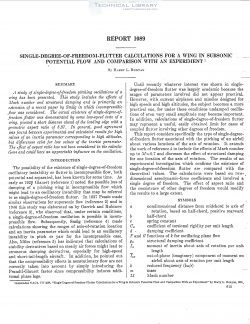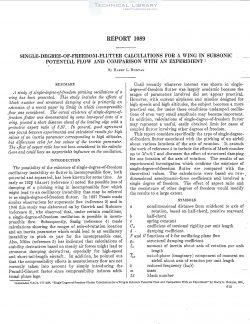naca-report-1089

- Version
- 179 Downloads
- 874.09 KB File Size
- 1 File Count
- September 7, 2016 Create Date
- September 7, 2016 Last Updated
National Advisory Committee for Aeronautics, Report - Single Degree of Freedom Flutter Calculations for a Wing in Subsonic Potential Flow and Comparison with an Experiment

A study of single—degree-oj—freedom pitching oscillations of a
icing has been presented. This study includes the ejects of
hfach number and structural damping and is primarily an
extension of a recent paper 6y Smilg in which incompressible
flow was considered. The actual existence of single-degree-of—
freedom flutter was demonstrated by some low-speed tests of a
wing, pivoted a short distance ahead of the leading edge with a
geometric aspect rat-to of 5.87. In general, good agreement
was found between experimental and calculated results for high
ralues of an inertia parameter corresponding to high altitudes,
but differences erist for low mines of the inertia parameter.
The eflect of aspect ratio has not been. considered in the calcula-
tions and could have an appreciable influence on the oscillation.
The possibility of the existence of single-degree-of—freedom
oscillatory instability or flutter in incompressible fiow,vboth
potential and separated, has been known for some time. As
early as 1929 Glauert {reference 1) noted the possible loss of
damping of a pitching Wing in incompressible flow which
might lead to an oscillatory instability that may be referred
to as single-degree-of-freedom flutter In 1937 Possio made
similar observations for supersonic flow (reference 2) and 1n
1946 this study was elaborated on by Garrick and Rubinow
(reference 3), who observed that, under certain conditions,
a single-degree—of~frcedom oscillation is possible in incom-
pressible flow. Subsequently, Smllg (reference 4) made
calculations showing the ranges of axis-of-rotation location
and an inertia parameter which could lead to an oscillatory
instability in pitch or yaw for the incompressible case.
Also, Miles (reference 5) has indicated that calculations of
stability derivatives based on steady air forces might. lead to
erroneous damping derivatives, especially for high—speed
and short—tail-length aircraft. In addition, he pointed out
that the compressibility efiects in nonstationary flovv are not-
correctly taken into account by simply introducing the
Prandtl-Glauert factor since compressibility induces addi-
tional phase lags.
| File | Action |
|---|---|
| naca-report-1089 Single Degree of Freedom Flutter Calculations for a Wing in Subsonic Potential Flow and Comparison with an Experiment.pdf | Download |
Comment On This Post